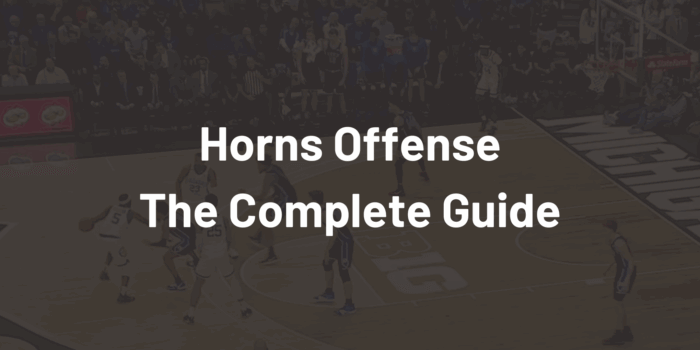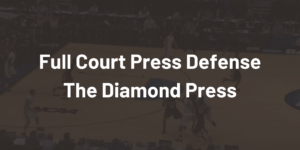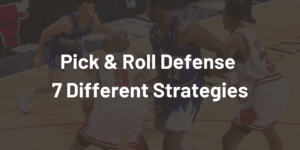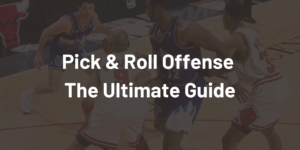Every coach is searching for the right offensive setup: one that creates space, fits their personnel, and keeps defenses guessing. That’s why the Horns Offense has stood the test of time. With two bigs at the elbows and shooters in the corners, Horns offers more than just structure. It opens up a world of scoring options, from pick-and-rolls to flex cuts to modern Zoom actions. Whether you're coaching youth or college, understanding how Horns works, and how to teach it, can give your team an edge.
What is the Horns Offense?
The Horns Offense is a versatile system built from a distinctive setup known as the Horns formation.
In this alignment, the ball handler (typically the point guard) starts at the top of the key. Two bigs, usually the power forward and center, position themselves at each elbow (the high post areas), while the remaining two players space out in the corners. This 1-2-2 shape resembles the horns of a bull, which gives the offense its name.
But the Horns Offense is more than just a formation; it's a family of actions that can be tailored to suit nearly any team or roster type.
At its core, Horns provides two primary options to initiate the offense:
1. Double Ball Screen:
The ball handler is given a choice between two high ball screens, one from each elbow (or higher up, as needed). This forces the defense into a read-and-react scenario, making it impossible to funnel the ball handler in a predictable direction. From here, the offense can flow into pick-and-rolls, pick-and-pops, slips, or swing actions, depending on how the defense reacts.
2. Elbow Entry (High Post Initiation):
Alternatively, the ball handler may pass to one of the bigs at the elbow, triggering a sequence of off-ball screens, handoffs, or split actions. This option shifts the playmaking responsibilities to the high post, encouraging inside-out movement and involving multiple players simultaneously.
Let's take a deeper look at all the options out of the Double Ball Screen.
Options Out of the Double Ball Screen
A double ball screen, where the ball handler receives simultaneous screen options from both bigs positioned at the elbows, is effective because it forces the defense into immediate decision-making. With screens on both sides, the defense can no longer dictate the direction of the ball handler. This neutralizes "Weak" coverage, where defenders typically try to force the ball to the handler’s weaker hand or away from the primary action.
Pick and Roll
Once the ball handler chooses a side, they can initiate a simple screen action. The big who sets the screen has two options: they can dive to the basket, looking to capitalize on any gaps created by the defensive coverage, or they can pop out to the perimeter for a potential catch-and-shoot opportunity. If the screener rolls, the big on the opposite elbow will pop out to the perimeter. If the screener pops, the opposite big will dive toward the basket instead. This preserves spacing and maintains pressure on the interior defense. Either way, this basic action already creates a three-man read: the roller, the popper, and the ball handler. It gives the offense multiple layers of decision-making right out of the gate.
When the screens on both sides are set, the ball handler can choose a side and initiate a simple screen action.
If the screener rolls, the big on the opposite elbow will pop out to the perimeter.
If the screener pops, the big on the opposite elbow will dive towards the basket.
Horns Twist
Or, the ball handler can use both screens sequentially to throw off the defender and disrupt the coverage. In this variation, the ball handler attacks in one direction off the first screen, forcing the on-ball defender to commit; then, they quickly change direction to use the second screen, shifting the action to the opposite side. It’s similar to a twist screen or Varejao screen, except it’s executed with two screeners from the start.
After using the first screen, the initial screener dives to the basket, putting pressure on the interior defense. Then, once the ball handler uses the second screen, the second screener also rolls. Meanwhile, the first screener (after rolling) fades or pops out to the three-point line. This layered movement forces the defense to identify who tags the first roller, who helps on the second, and who closes out on the pop; often, that sequence creates hesitation or miscommunication in the backline.
Horns Flare
Horns Flare is another popular option out of the Horns Offense, especially when using the double ball screen setup. It creates a quick decision-making moment for the defense by combining off-ball screening with an perimeter and interior threat.
In this action, the ball handler first uses one of the high ball screens. After setting the initial screen, that screener receives a flare screen from the opposite big, allowing them to flare out to the three-point line for a potential catch and shoot opportunity. At the same time, the second screener, who set the final ball screen, dives hard to the rim.
These are three of the most basic (but most effective) Horns actions out of the double ball screen. You may have noticed a common theme in all of them: one screener rolls, and the other pops. They're never doing the same thing at the same time, and that’s by design. Having both screeners roll, or both pop, would crowd the floor and break the spacing that makes the Horns Offense so effective in the first place.
Some coaches might ask: Aren’t these Horns actions out of the double ball screen predictable? If the defense knows that one screener will roll and the other will pop, can’t they just switch and neutralize the action?
That’s a fair question. And it’s exactly why the small details and subtle variations matter so much in the Horns Offense. The core structure may stay the same, but what separates a good Horns team from a great one is their ability to disguise intentions, change screen angles, tweak timing, and adjust personnel matchups. These minor adjustments create just enough hesitation to punish switches, exploit miscommunication, and keep defenders guessing, even when they know what's coming.
One effective variation is to have a wing or guard set one of the ball screens instead of a big. This works especially well when you're facing defenders who aren't used to navigating ball screens, such as opposing wings or smaller guards. While bigs typically have more experience defending screen actions, perimeter defenders may be more prone to overhelp, switch too early, or trail poorly. This opens up opportunities for slips, mismatches, or clean pull-ups.
Coaches can also have the screener slip the screen if the defense is preparing to switch on contact. Even more deceptively, they may opt for a ghost screen.
These tactics are effective because most defenses rely on verbal cues and timing to execute their coverage. The screener’s defender will often call out the switch or hedge just as the screen is being set, and the on-ball defender is trained to respond once contact occurs. But if that contact never happens, or happens too briefly, it creates a moment of hesitation and confusion. In that split second, neither defender is fully committed to the scheme they just called out, which is often enough for the offense to get downhill or find an open shooter.
So while it’s important for players to learn the plays, it may be even more critical for them to understand why the small details matter. The difference between a successful possession and a shot clock violation often comes down to timing: reading the defense, and recognizing how to use slight variations to create advantages.
Teaching players these nuances helps them play as thinking basketball players, not robots going through the motions. When they understand why they’re rejecting a screen, why they’re slipping early, or why one big pops while the other rolls, they become much more effective decision-makers. That’s when the Horns Offense transforms from a set play into a dynamic system that adapts in real time, and that’s where the real growth happens.
Now let's dive into the Elbow Entry options.
Options Out of the Elbow Entry
While the double ball screen is a powerful way to initiate Horns, it’s only one side of what makes this setup so versatile. The other common (and equally effective) entry is through the elbow. Instead of using the screens directly, the ball handler passes to one of the bigs positioned at the elbow, triggering a different sequence of actions. This shifts the offense from a guard-initiated attack to a high-post playmaking structure, creating new angles for cuts, handoffs, and split actions that involve the entire team.
Elbow Handoff Chase Action
The ball handler can initiate the offense by passing to one of the bigs at the elbow, then immediately following the pass to receive a simple handoff. As soon as the pass is made, the opposite big cuts hard toward the basket, looking to draw help or slip behind the defense.
After the handoff, the big who delivered it has two options:
- Pop to the perimeter if the opposite big is still near the paint, maintaining proper spacing and giving the ball handler a driving lane or kick-out option.
- Cut to the basket if the opposite big has cleared out to the perimeter (often by flaring to the three-point line), leaving the paint open.
This read ultimately depends on what the team has predetermined as the action. While it's certainly possible for the big to make the decision on the fly based on how the defense reacts, it's often better (especially at the high school or developmental levels) for players to simplify their responsibilities. When roles are clearly defined, the offense flows more smoothly, and players can focus on timing and execution rather than overthinking.
And once again, this sequence emphasizes a familiar principle in the Horns Offense: one roll man, one pop man. Maintaining that contrast preserves spacing, stretches the defense vertically and horizontally, and ensures that every movement opens up multiple scoring options without crowding the floor.
Horns Zoom
Of course, Elbow Chase Action is not the only handoff option available from the Horns setup. Instead of receiving the handoff themselves, the ball handler can pass to the elbow and immediately set an off-ball screen for a teammate (usually a wing or corner shooter), who then comes up to receive the handoff from the big. This sequence is commonly referred to as Zoom Action, and the Horns alignment is an ideal way to flow into it.
The most basic read in Horns Zoom is the Zoom curl, where the cutter comes tight off the off-ball screen to receive the handoff and immediately turns the corner, looking to drive, pull up, or kick out to a shooter if the defense collapses. However, Zoom Action is far from one-dimensional, and different variations can be found here.
Horns Split Action
Another powerful option out of the elbow entry is the split action, which activates as soon as the ball is passed from the point guard to one of the bigs at the elbow. After making the pass, the ball handler doesn’t just stand still. Instead, they immediately screen for the other big at the elbow or for the player in the strongside corner. This creates a quick two-man screening action on the perimeter, commonly referred to as a "split."
The player receiving the screen has multiple reads depending on how their defender reacts. They can curl around the screen toward the basket, flare out to the perimeter for a potential three, or reject the screen and backcut if the defense overplays. Meanwhile, the big who received the elbow pass becomes the high-post facilitator. If the cutter gets open, the big can hit them with a quick bounce pass. If the flare is open, it’s a simple catch-and-shoot. If nothing develops, the big can fake a handoff, attack off the dribble, or swing the ball to the opposite side to reset the offense.
The strength of split action lies in its simplicity and built-in spacing. It keeps the ball centered, activates off-ball movement, and forces defenders to communicate quickly. If the defense switches, it may create mismatches. If they trail, it opens cutting lanes. If they hedge or help too hard, it frees up the shooter. It’s an action that doesn’t rely on elite athleticism or complexity. Instead, it rewards sharp screens, decisive reads, and ball sharing.
Because this action occurs naturally within the Horns setup, it can also be layered into other options. If the split doesn’t create a shot, the offense can flow into a dribble handoff, side pick-and-roll, or even a high-low pass, especially if the opposite big is sealing inside. That flexibility is what makes split action such a reliable and versatile tool for coaches at any level.
High-Low Action
Another valuable option out of the elbow entry is the high-low pass, which is especially effective when you have a big who can pass from the high post and another who can establish strong position inside. After the ball handler passes to one of the bigs at the elbow, the opposite big immediately dives toward the low block, sealing their defender in the paint. This move must be timed precisely: it should be initiated right as the elbow catch is made, so the defense doesn’t have time to load up or rotate early.
Once the high post player catches the ball, their job is to read the low defender. If the seal is good and help hasn't arrived, they can drop a direct bounce pass or lob over the top. If help comes early, the passer can use a fake to shift the defense or swing the ball to the opposite side for a second look. It’s not about rushing the pass. It’s about recognizing spacing and leverage. The player in the low post should be physical but patient, using their body to maintain position and adjusting to where the help is coming from.
The high-low is also a great counter when teams are denying the wings or switching off-ball screens aggressively. Instead of fighting through traffic to get guards involved, the offense plays through the bigs, leveraging size, timing, and interior positioning. This not only creates scoring chances near the rim, but also encourages ball movement and spacing, since defenders are forced to collapse inside.
And because it stems directly from the Horns alignment, the spacing remains clean: corner shooters stay lifted, the ball-side elbow is occupied by the passer, and the paint is temporarily cleared for the dive. If the entry pass isn’t there, the high post big can still reverse the ball or initiate a handoff, keeping the offense flowing without a reset.
Horns Flex
Perhaps the most well-known, and possibly the oldest, offensive action out of the Horns setup is the Horns Flex.
The action begins with the ball handler passing to one of the bigs at the elbow. Immediately after the pass, the ball handler cuts down through the middle of the lane to set a flex screen for the player stationed in the weakside corner. That corner player uses the screen to make a hard flex cut across the baseline, looking to catch the pass near the ball-side block for a quick layup or post finish.
Simultaneously, as the flex screen is being set, the big on the opposite elbow sets a down screen for the original ball handler, who curls or pops up to the top of the key. If the flex cut is open, the elbow passer delivers the ball inside for an easy scoring opportunity. If the defense covers the cut, the pass can be reversed to the original ball handler, now receiving the ball up top with momentum or space to shoot, attack, or make the next read.
From there, several options can unfold. If the initial ball handler receives the ball at the top, they can flow into a two-man game with the screener (typically the big who set the down screen). This can turn into a pick-and-roll, a dribble handoff, or a pass-and-follow action. Meanwhile, the player who made the flex cut and didn’t receive the ball will flare out to the corner or wing, helping maintain spacing and becoming a secondary shooting threat.
Other Noteable Plays
Horns Stagger (Blast)
Horns Stagger is a stagger action out of the Horns alignment. Blast is another term for a backdoor cut. Combining the two creates a Horns Stagger variation.
After the ball handler passes the ball to one of the elbows, the ball handler will set a stagger screen with the opposite elbow for the weakside corner. The player in the weakside corner can come up to the top of the key and initiate the offense.
In the Blast variation, the player in the strongside corner will lift to the wing and actively look for a backdoor cut opportunity.
Horns Stagger is a stagger action out of the Horns alignment. Blast is another term for a backdoor cut. Combining the two creates a Horns Stagger variation.
After 1 passes the ball to one of the elbows, 1 will set a stagger screen with 5 for the weakside corner.
- 3 can come up to the top of the key and initiate the offense.
- The #2 will lift to the wing and actively look for a backdoor cut opportunity.
Horns Elbow Get
Horns Elbow Get is a variation of Horns High-Low Action
1 passes the ball to the big at the elbow (4). Immediately after the pass, the opposite elbow player (5) sets a screen for 4.
Using the screen, 4 attacks downhill while looking for 5 on the roll. This action is effective because if the defense switches, 5 often gains inside position on a smaller defender. If there’s no switch, 4 and 5 can play a quick two-on-one near the basket, creating a high-percentage scoring chance.
Horns Elbow Get is a variation of Horns High-Low Action
1 passes the ball to one of the elbows (4). Then the opposite elbow (5) sets the screen for 4.
4 uses the screen, and looks for the rolling 5.
This is useful because 5 will typically have the inside position if the defenders switch. If the defenders do not switch, 4 and 5 can play 2v1 close to the basket.
Horns Offense Drills for Players
There are countless variations of the Horns Offense, but almost all of them come down to two foundational skills: reading the defense and shooting off screens. These aren’t just Horns-specific skills; they’re critical in any modern offensive system. What makes Horns unique, though, is how consistently those reads show up from specific locations and angles on the floor.
That’s why I’ve put together a few drills that help players develop these skills within the Horns setup. These drills are designed not only to sharpen execution, but to help players get comfortable with floor spacing, timing, and recognizing different defensive looks that naturally arise in Horns. Of course, these are not the only drills that can accomplish this. If you already have your own progressions for teaching screen reads or shooting on the move, those can easily be adapted into the Horns framework.
The point is simple: get your players to read, react, and shoot in the structure you plan to run. The more reps they get seeing these reads within the Horns spacing, the more confident and instinctive they’ll become when it matters.
Now, here are some practical Horns Offense drills built around those core ideas:
Horns 2v2 Read & Counter Drill
This drill trains both offensive decision-making and defensive pressure within the Horns setup. Offensive players work on making live reads out of an elbow entry, while defenders focus on denying entry passes, applying tight ball pressure, and disrupting timing. It's exactly the kind of resistance they'll face in a real game.
This drill trains both offensive decision-making and defensive pressure within the Horns setup. Offensive players work on making live reads out of an elbow entry, while defenders focus on denying entry passes, applying tight ball pressure, and disrupting timing—exactly the kind of resistance they'll face in a real game.
- The ball handler starts at the top of the key.
- A teammate is stationed at one of the elbows (either one), with two live defenders guarding both players.
- A cone is placed at the opposite elbow to simulate a screen.
The drill begins with the ball handler passing to the elbow. After the pass, the ball handler makes a decision:
- Chase for a handoff. The ball handler runs directly toward the elbow player to receive a dribble handoff, then reads the defense to either turn the corner, pull up, or hit the roller (in full-speed variations).
- Use the cone at the opposite elbow like a screen. From here, the ball handler has 2 more reads
- If the defender goes under the cone (sags off), the ball handler flares out behind the cone for a catch-and-shoot three.
- If the defender trails, the ball handler cuts tight off the cone toward the basket for a layup opportunity.
The defender at the elbow must play tight and work to deny the catch at the elbow. Ideally, they should try to push their man off the elbow and challenge the entry pass timing. Both defenders should be active and physical, applying pressure without fouling, and be alert for stealing the entry pass if the angle is soft or late.
Horns Matchup Drill (3v3 Competitive Game)
This drill puts players in live 3-on-3 situations using only Horns-based actions. It reinforces spacing, timing, and offensive execution while challenging defenders to communicate, switch, and contain within the Horns framework. It also encourages players to apply multiple variations of Horns—not just run a script.
- Divide players into groups of three.
- Place one group on offense and one on defense in a Horns setup: ball handler at the top, two players at the elbows.
- The remaining groups wait on the sideline, ready to rotate in.
The offense chooses any Horns action to run: a simple PnR, Horns Twist, Horns Flare, Zoom Action, Flex Cut, Elbow Entry with Split—any action covered in the playbook or creatively improvised. Play it out live until a shot is attempted or the possession ends.
If the offense scores, they stay on offense and a new group rotates in on defense. If the defense gets a clean stop (e.g. forces a turnover, contested miss, or shot clock violation), the defense becomes the new offense, and a new team rotates in as the defense. If the offense runs a good action and gets a quality shot but misses, both teams rotate out. (This prevents overly cautious play and encourages smart, aggressive execution.)
Coaches can run this drill in King of the Court style, or use a point system (e.g., 2 points for a made basket, 1 point for a quality possession, 1 point for a stop). Coaches should give players pre-round time to call their Horns action and assign roles, emphasizing communication and adaptability.

Basketball Strategy and Performance Analyst. Passionate about breaking down the game to its core, combining in-depth basketball insights with data-driven analysis to elevate understanding of the sport.







